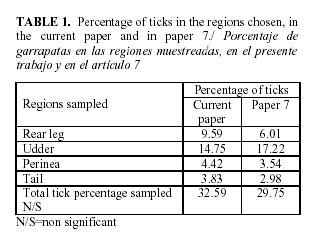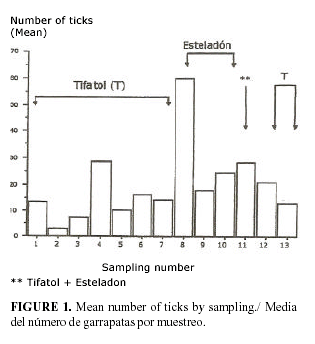My SciELO
Services on Demand
Article
Indicators
-
 Cited by SciELO
Cited by SciELO
Related links
-
 Similars in
SciELO
Similars in
SciELO
Share
Revista de Salud Animal
Print version ISSN 0253-570X
Rev Salud Anim. vol.31 no.2 La Habana May-Aug. 2009
Artículo original
APPLICATION OF TICK SAMPLING ON ACARICIDAL BATH FREQUENCY IN Rhipicephalus (Boophilus) microplus (ACARI: IXODIDAE)
APLICACION DEL MUESTREO DE GARRAPATAS EN LA FRECUENCIA DEL BAÑO ACARICIDA EN Rhipicephalus (Boophilus) microplus (ACARI: IXODIDAE)
R. de la Vega*, G. Díaz**, A.Camejo* e I. García***
*LABIOFAM, Apartado 34, General Peraza, CP-19210, Ciudad Habana, Cuba, FAX: (537)334857, E-mail: delavega@infomed.sld.cu; **Facultad de Biología, Universidad de La Habana; *** Instituto Pedro Kourí (IPK), Ciudad Habana, Cuba
ABSTRACT
In this paper, a tick sampling method developed by authors was employed with the purpose of saving acaricides and decreasing environmental pollution by the use of acaricidal dip control bathing bovines in relation to a critical number of estimated ticks. Twenty-six Jersey cows in production were sampled. The selected sampling regions were: rear leg, udder, perinea and tail. Samplings were done from 7 to 8 am, and female tick standard size pattern was 6 mm or longer. Every two weeks approximately, samplings and acaricidal baths were done (13 samplings in total). Only cows with 10 or more ticks received acaricidal baths. Results showed that the procedure allows saving 50% of acaricides.
Key words: Rhipicephalus (Boophilus) microplus; tick; acaricide; sampling
RESUMEN
En el presente trabajo se utilizó un método de muestreo de garrapatas previamente desarrollado por los autores, con el objetivo de regular el empleo del baño acaricida en bovinos. Esto permitiría un ahorro sustancial de acaricidas y la disminución de la polución ambiental. Se trabajó con 26 vacas de raza Jersey en producción y se escogieron las regiones corporales del animal que resultaron buenos estimadores del total de garrapatas: extremidad posterior, ubre, periné y cola. Los muestreos se realizaron cada dos semanas aproximadamente, de 7:00 a 8:00 am y la garrapata patrón para el muestreo fue de 6mm o más de largo, Se realizó un total de 13 muestreos. Se escogió 10 como número límite máximo de garrapatas permitidas para que los bovinos no recibieran baño. Este trabajo permitió el ahorro del 50 % de acaricidas.
Palabras clave: Rhipicephalus (Boophilus) microplus; garrapata; acaricida; muestreo
INTRODUCTION
One of the major economic important tick of the tropical regions is Rhipicephalus (Boophilus) microplus. This tick is responsible of important losses in these areas, according with Springell (1). In 1974 in Australia the losses estimated reached 62 million dollars, $6.40 per beast per year and 11% of the total corresponded to the cost of acaricides. Grisi et al. (2) in Brazil estimated the whole loss provoked by this ectoparasite reached 2000 million dollars and the cost per cow per year in Brazil calculated from his data was $11.83, that is 2000 million dollars/169 million cattle heads.
For tick control, it is mandatory the use of a sampling method, scientifically developed and validated, in order to monitor the different control actions undertaken and the employed chemicals and others like vaccines. Another application of tick sampling would be the regulation of the acaricidal bath frequency. That is, the establishment of a logical tick number to allow bathing a bovine or not. Tick sampling could be very important to relate milk and meat loss per tick and to know tick seasonal dynamics and geographical distribution of a determined species.
In 1970, Wharton and Utech (3) observed in groups of no more than four bovines that female ticks (Boophilus microplus) from 4.5 to 8 mm in length viewed at 9 to 11 am dropped before the next 24 hours. They established a sampling method: count all females from 4.5 to 8.0 mm at 9 to 11 am in one-half of the cow and the result is multiplied by two. There are some practical problems: too big area, too small ticks and not evidence of the same number of ticks in each side of the bovine. Other authors have developed tick sampling methods in other species (4,5,6). In Cuba, the sampling methods on B. microplus have been developed in dairy cows and young bovines (7,8,9). In this paper, one of these methods was validated and employed with the purpose of saving acaricides and decreasing environment pollution by the use of acaricidal dip control bathing cows in relation to a critical number of estimated ticks.
MATERIALS AND METHODS
Twenty-six Jersey cows in production were sampled with a method developed by the authors for estimation of number of cattle ticks B. microplus (7). The percentage of ticks of each 28 body regions in the bovine was calculated in order to estimate the total number of ticks and determine if there was difference or not from the original paper regarding distribution. From this result, the best body regions were chosen for estimation of the number of ticks. The selected sampling regions were: rear leg, udder, perinea and tail. Samplings were done from 7 to 8 am, and female tick standard size pattern was 6 mm or longer. Every two weeks approximately, samplings (13 in total) and acaricidal baths were done. Only cows with 10 or more ticks received acaricidal baths; this number of ticks is enough to maintain the enzootic stability of the herd (10). The acaricidal products used were Esteladon and Tifatol. Proportions of ticks (P) in selected bovine regions were transformed 2 arsin(SQRT(P)) and compared using t-paired test.
RESULTS AND DISCUSSION
Table 1 shows the regions chosen for total number estimation of ticks; percentages were compared by means of a t-paired test. Results showed that there were not significant differences between them (P<0.05). The fact that the percentages taken in the regions chosen for total tick number estimation did not differ from those from the previous paper (7), suggests that ticks' body distribution is more dependent from biological characteristics of the host, than from the different prevailing environmental factors. The same fact was observed recently for the 28 sampling regions, with cows in Seropedica, Brazil (not published data).

Figure 1 exhibits the results of all samplings. Between the 7th and 8th sampling and for technical reasons, 28 days elapsed for dipping and number of ticks grew a lot. At that moment, Tifatol was stopped and changed to Esteladon; and in the 9th sampling, number of ticks shut down apparently by the efficiency of the product, but in the two next samplings, the number of ticks increased again and both products were mixed up with goods results. During the experiment, 273 cows were sampled, 50% of them had less than 10 ticks and did not received acaricidal treatment. This implied great savings of money and an important decrease in environmental pollution. Results show that systematic samplings give the possibility of a more rational treatment before ticks' infestation reaches high levels. An appropriate and moderate use of chemicals in tick control has been recommended in order to avoid resistance to acaricides (11). Ticks and tick-borne disease control are affected by the widespread use of acaricides, leading to various problems such as resistance, chemical residues, environmental pollution and high cost (12). Also it is causing a loss of the enzootic stability to hemoparasites. The use of the sampling method proposed for acaricidal dip control accomplishes the recommendations cited and ensures the prevention of those problems.

REFERENCES
1. Springell PH. The cattle tick in relation to animal production in Australia. Rev. Zootecnia. FAO. 1974;10:19-23.
2. Grisi L, Massard CI, Moya Borja GE, Pereira JB. Impacto econômico das principais ectoparasitoses em bovinos no Brasil. A Hora Veterinária 2002; No.125, Janeiro/fevereiro: 8-10.
3. Wharton RH, Utech KBW. The relation between engorgement and dropping of Boophilus microplus (Canestrini) (Ixodidae) to the assessment of tick numbers on cattle. J Aust Ent Soc. 1970;9:171-182.
4. Barnard DR, Morrison RD. Density estimators for populations of the lone star tick, Amblyomma americanum (Acari: Ixodidae), on pastured beef cattle. J Med Entomol. 1985;22(3):244-9.
5. Barnard DR, Morrison RD, Terry Ervin R. Sites of Attachment and Density Assessment in Amblyomma americanum (Acari:Ixodidae) on Nursing Beef Calves. Exp App Acarol. 1989;6:245-252.
6. L'Hostis M, Diarra O, Seegers H. Sites of attachment and density assessment of female Ixodes ricinus (Acari: Ixodidae) on dairy cows. Exp Appl Acarol. 1994;18:681-689.
7. de la Vega R, Moreno A, Díaz G. Método de muestreo de la garrapata del ganado vacuno (Boophilus microplus) en vacas lecheras. Rev Salud Anim. 1984;6:397-406.
8. de la Vega R, Díaz G. Muestreo de garrapatas (B. microplus) para vacas en ordeño mecanizado. Comunicación Corta. Rev Salud Anim. 1987;9:363-5.
9. de la Vega R, Díaz G. Tick sampling method for Boophilus microplus in young bovines. In: Recombinant Vaccines for the Control of Cattle Tick. Monograph. Elfos Scientiae. 1995; 21-6.
10.Dalgliesh RJ. Consideraciones actuales sobre las babesiosis y anaplasmosis del ganado bovino. FAO. Traducción Dr. R. Silvestri, Facultad de Ciencias Veterinarias, Universidad Central de Venezuela. Boletín de Reseñas, Veterinaria 1979; 1-59.
11.Furlong J, Martins JR, Prata MCA. O carrapato dos bovines e a resistência: temos o que comemorar? A Hora Veterinária 2007; No. 139, setembro/outubro: 1-7.
12.Ghosh S, Azhahianambi P, Yadav MP. Upcoming and future strategies of tick control: a review. J Vect Borne Dis. 2007;44:79-89.
(Recibido 5-1-2009; Aceptado 20-4-2009)














